Get free scan and check if your device is infected.
Remove it nowTo use full-featured product, you have to purchase a license for Combo Cleaner. Seven days free trial available. Combo Cleaner is owned and operated by RCS LT, the parent company of PCRisk.com.
What kind of malware is PS1Bot?
PS1Bot is the name of a malicious software that is essentially a multi-stage malware framework. It is a modular malware that utilizes various modules to perform malicious activities on infected devices.
PS1Bot has been used to ensure persistence on systems, gather sensitive data, and carry out other harmful actions. This malware has been actively spread through malvertising campaigns that began in 2025.
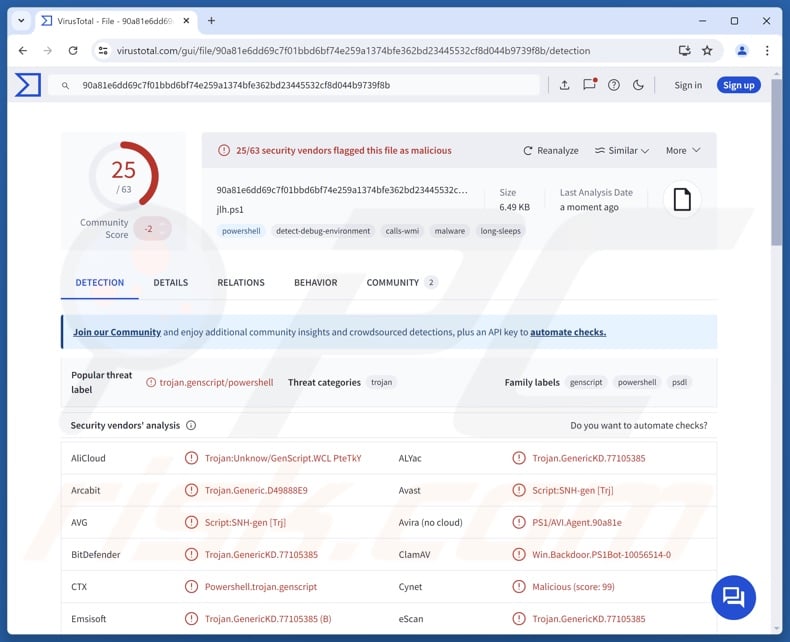
PS1Bot malware overview
Upon successful infiltration, PS1Bot begins by collecting relevant device data. Afterward, the malware seeks to establish contact with its C&C (Command and Control) server.
As mentioned in the introduction, this malicious software is a modular malware. From its C&C server, PS1Bot can obtain modules to expand its capabilities. The totality of the modules used by this malware is unknown, as it is likely greater than those that are known as of the time of writing. PS1Bot executes its modules in-memory, thus diminishing the chances of detection.
Observed PowerShell modules used by PS1Bot include those intended for: antivirus detection, additional reconnaissance, persistence ensurance, taking screenshots, exfiltrating files/data, and keylogging.
In the known attacks, PS1Bot first introduced a module that checks the device for installed antivirus software. Afterward, it used a different module to acquire more information concerning the compromised machine, potentially to determine whether the malware infected a highly valuable target like a corporate entity.
PS1Bot's data-targeting modules have the ability to take screenshots, monitor keyboard and mouse input, record keystrokes (keylogging), and steal clipboard (copy-paste buffer) content. This malware also uses additions for downloading files that contain vulnerable data, such as passwords, cryptowallet passphrases, and similar.
PS1Bot aims to obtain sensitive information from browsers, browser extensions, desktop cryptocurrency wallets, and authentication software (full list below). The malware targets Internet cookies, session tokens, log-in credentials, and other data.
It is noteworthy that malware developers often improve upon their creations and methodologies. Furthermore, PS1Bot is a modular malware that can use a variety of additions for extra functionality. Therefore, it is probable that PS1Bot's capabilities can differ between infections.
To summarize, the presence of malicious software like PS1Bot on devices can lead to severe privacy issues, financial losses, and identity theft.
| Name | PS1Bot virus |
| Threat Type | Trojan, malware framework, multi-stage malware framework, modular malware. |
| Detection Names | Avast (Script:SNH-gen [Trj]), Combo Cleaner (Trojan.GenericKD.77105385), ESET-NOD32 (GenScript.WUW), Kaspersky (HEUR:Trojan.PowerShell.Generic), Microsoft (Trojan:Win32/Alevaul!rfn), Full List Of Detections (VirusTotal) |
| Symptoms | Trojans are designed to stealthily infiltrate the victim's computer and remain silent, and thus no particular symptoms are clearly visible on an infected machine. |
| Distribution methods | Infected email attachments, malicious online advertisements, social engineering, software 'cracks'. |
| Damage | Stolen passwords and banking information, identity theft, the victim's computer added to a botnet. |
| Malware Removal (Windows) |
To eliminate possible malware infections, scan your computer with legitimate antivirus software. Our security researchers recommend using Combo Cleaner. Download Combo CleanerTo use full-featured product, you have to purchase a license for Combo Cleaner. 7 days free trial available. Combo Cleaner is owned and operated by RCS LT, the parent company of PCRisk.com. |
Examples of modular malware
We have written about countless malicious programs; PipeMagic, Squidoor, Shadowpad, and I2PRAT are just some of our newest articles on modular malware.
Malware is an incredibly broad term that covers programs with a wide range of malicious functionalities. Yet how malignant software operates is irrelevant, as its presence on a system endangers device integrity and user safety regardless. Therefore, all threats must be eliminated immediately upon detection.
How did PS1Bot infiltrate my computer?
PS1Bot-spreading campaigns were first observed at the beginning of 2025. This activity has been highly active and involves malvertising (malicious advertising) and social engine poisoning techniques.
Typically, PS1Bot arrives onto systems in a compressed archive. Known filenames related to popular search words, e.g., "chapter 8 medicare benefit policy manual.zip", "Counting Canadian Money Worksheets Pdf.zip.e49", "kosher food list pdf (1).zip.c9a", "pambu panchangam 2024-25 pdf.zip.a7a", "zebra gx430t manual.zip.081", etc.
However, other distribution methods are not unlikely. Phishing and social engineering tactics are standard in malware proliferation. Malicious programs are usually disguised as or bundled with ordinary content. Infectious files come in various formats, e.g., archives (ZIP, RAR, etc.), executables (.exe, .run, etc.), documents (Microsoft Office, Microsoft OneNote, PDF, etc.), JavaScript, and so on. Merely opening a malicious file can be enough to initiate the infection chain.
Malware is primarily spread via malvertising, online scams, drive-by (stealthy/deceptive) downloads, malicious attachments or links in spam (e.g., emails, PMs/DMs, social media posts, etc.), trojans (backdoors/loaders), suspicious download channels (e.g., freeware and free file-hosting sites, Peer-to-Peer sharing networks, etc.), illegal software activation tools ("cracks"), pirated content, and fake updates.
What is more, some malicious programs can self-proliferate through local networks and removable storage devices (e.g., external hard drives, USB flash drives, etc.).
How to avoid installation of malware?
We highly recommend vigilance when browsing since fraudulent and malicious online content usually appears genuine and harmless. Incoming emails and other communications must be approached with caution. Attachments or links present in suspicious/irrelevant mail must not be opened, as they can be virulent.
Another recommendation is to download only from official and verified sources. All programs must be activated and updated using legitimate functions/tools, as those obtained from third-parties can contain malware.
We must emphasize the importance of having a reputable antivirus installed and kept up-to-date. Security software must be used to run regular system scans and to remove detected threats. If you believe that your computer is already infected, we recommend running a scan with Combo Cleaner Antivirus for Windows to automatically eliminate infiltrated malware.
List of targeted browsers:
7Star, Amigo, Atom, Avast Secure Browser, AVG Secure Browser, Blisk, Brave, CCleaner Browser, CentBrowser, Chedot, Chrome Beta, Chrome Canary, Chromium, Citrio, Coc Coc, Comodo Dragon, CoolNovo, Coowon, CryptoTab Browser, Elements Browser, Epic Privacy Browser, Google Chrome, Iridium, Kinza, Kometa, Maxthon, Microsoft Edge, Mustang, Naver Whale, Netbox Browser, Opera, Opera GFX, Orbitum, QQ Browser, SalamWeb, Sidekick, Sleipnir, Slimjet, Sputnik, SRWare Iron, Superbird, Swing Browser, Tempest, Torch, UC Browser, Ulaa, UR Browser, Viasat Browser, Vivaldi, Wavebo, Yandex.
List of targeted browser extensions (primarily those associated with cryptocurrency and authentication):
1inch, Aave, Argent, argent-x-starknet-wallet, Atomic-Wallet, Authenticator, Binance, bitget-wallet-formerly-bi, BitKeep, Blockchain Wallet, Braavos, braavos-starknet-wallet, Coin98, Coinbase, core-crypto-wallet-nft-ex, cryptocom-wallet-extension, Curve, Dapper, desig-wallet, Ellipal, Exodus, fewcha-move-wallet, gate-wallet, Harmoney, KardiaChain, Kepler, kepler-edge, Ledger, manta-wallet, martian-aptos-sui-wallet, MartianAptos, MetaMask, MetaMask-edge, MetaMask-Opera, Mycelium, Nami, okx-wallet, petra-aptos-wallet, Phantom, Ronin, rose-wallet, sender-wallet, subwallet-polkadot-wallet, SushiSwap, TerraStation, TON, Trezor, Tron, Trust-Wallet, TrustWallet, unisat-wallet, Uniswap, wallet-guard-protect-your, Wombat, XDEFI, xdefi-wallet, xverse-wallet, Yoroi, Zerion.
List of targeted desktop cryptowallets:
- Armory
- Atomic
- Binance
- Bitcoin Core
- Bytecoin
- Coinomi
- Daedalus
- Electrum
- Ethereum
- Exodus
- Guarda
- Ledger Live
- TrustWallet
- Zcash
List of targeted authentication software:
- Authy Desktop
Instant automatic malware removal:
Manual threat removal might be a lengthy and complicated process that requires advanced IT skills. Combo Cleaner is a professional automatic malware removal tool that is recommended to get rid of malware. Download it by clicking the button below:
DOWNLOAD Combo CleanerBy downloading any software listed on this website you agree to our Privacy Policy and Terms of Use. To use full-featured product, you have to purchase a license for Combo Cleaner. 7 days free trial available. Combo Cleaner is owned and operated by RCS LT, the parent company of PCRisk.com.
Quick menu:
How to remove malware manually?
Manual malware removal is a complicated task - usually it is best to allow antivirus or anti-malware programs to do this automatically. To remove this malware we recommend using Combo Cleaner Antivirus for Windows.
If you wish to remove malware manually, the first step is to identify the name of the malware that you are trying to remove. Here is an example of a suspicious program running on a user's computer:
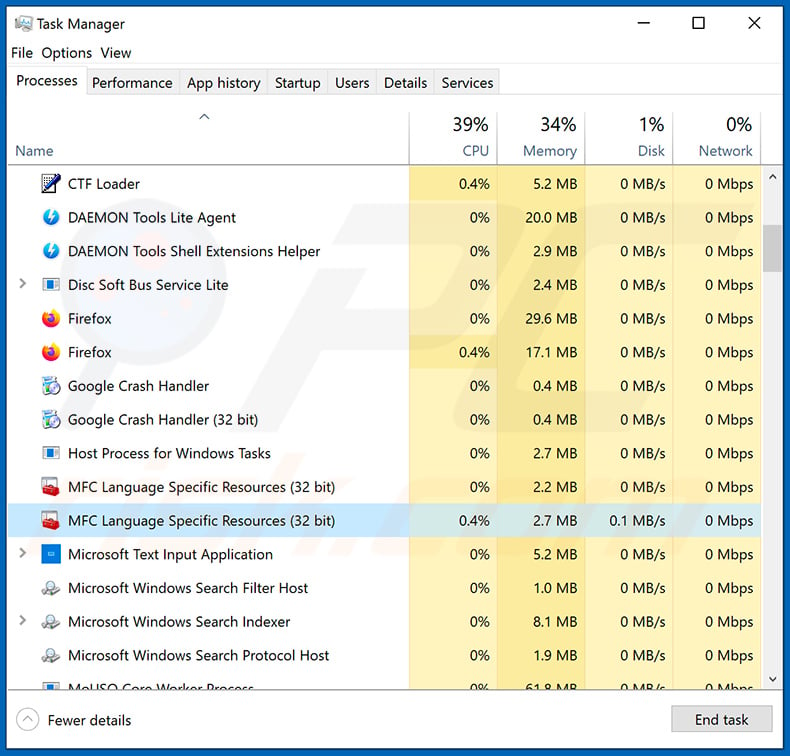
If you checked the list of programs running on your computer, for example, using task manager, and identified a program that looks suspicious, you should continue with these steps:
 Download a program called Autoruns. This program shows auto-start applications, Registry, and file system locations:
Download a program called Autoruns. This program shows auto-start applications, Registry, and file system locations:
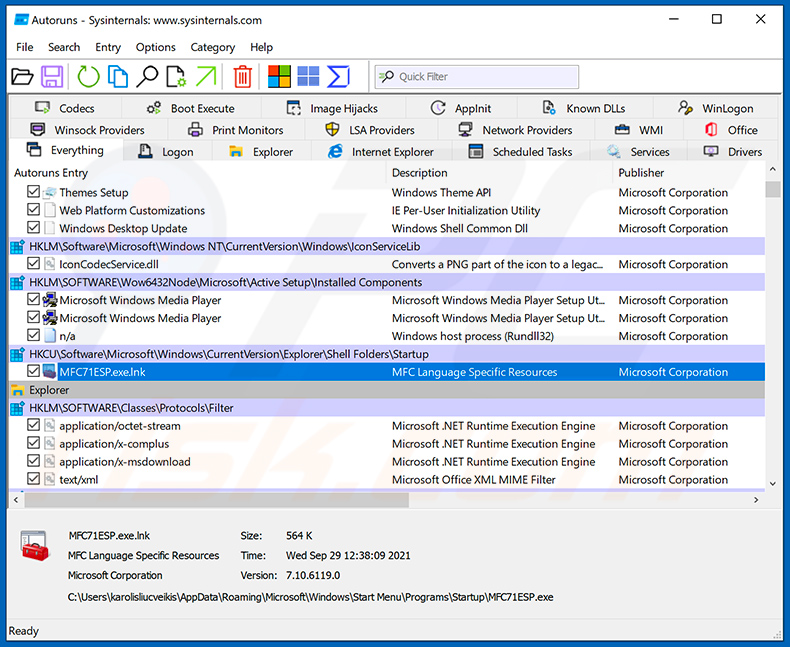
 Restart your computer into Safe Mode:
Restart your computer into Safe Mode:
Windows XP and Windows 7 users: Start your computer in Safe Mode. Click Start, click Shut Down, click Restart, click OK. During your computer start process, press the F8 key on your keyboard multiple times until you see the Windows Advanced Option menu, and then select Safe Mode with Networking from the list.
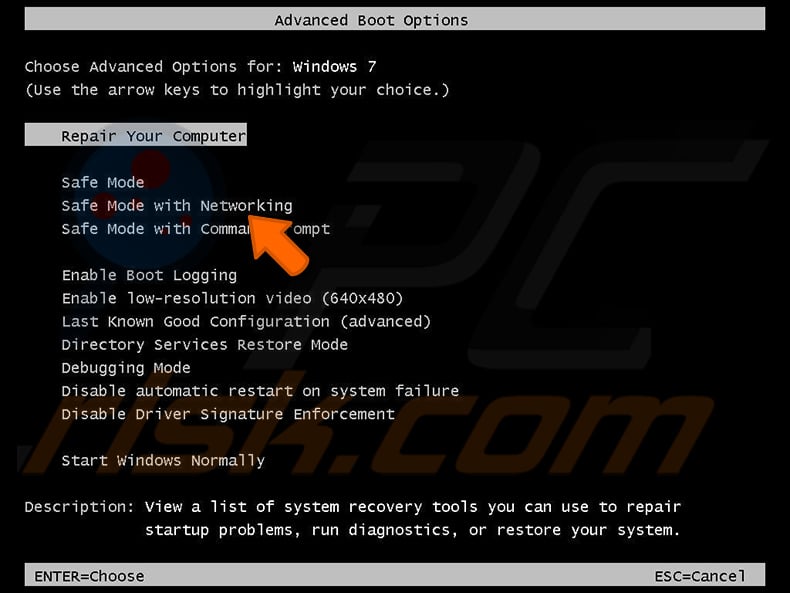
Video showing how to start Windows 7 in "Safe Mode with Networking":
Windows 8 users: Start Windows 8 is Safe Mode with Networking - Go to Windows 8 Start Screen, type Advanced, in the search results select Settings. Click Advanced startup options, in the opened "General PC Settings" window, select Advanced startup.
Click the "Restart now" button. Your computer will now restart into the "Advanced Startup options menu". Click the "Troubleshoot" button, and then click the "Advanced options" button. In the advanced option screen, click "Startup settings".
Click the "Restart" button. Your PC will restart into the Startup Settings screen. Press F5 to boot in Safe Mode with Networking.
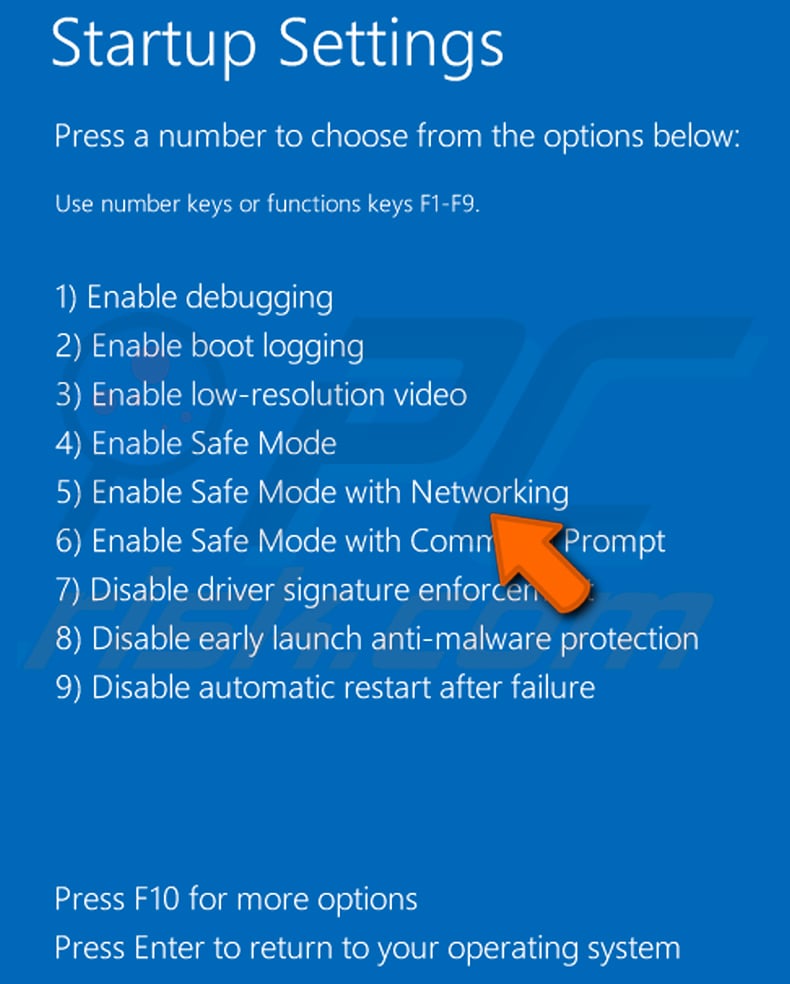
Video showing how to start Windows 8 in "Safe Mode with Networking":
Windows 10 users: Click the Windows logo and select the Power icon. In the opened menu click "Restart" while holding "Shift" button on your keyboard. In the "choose an option" window click on the "Troubleshoot", next select "Advanced options".
In the advanced options menu select "Startup Settings" and click on the "Restart" button. In the following window you should click the "F5" button on your keyboard. This will restart your operating system in safe mode with networking.
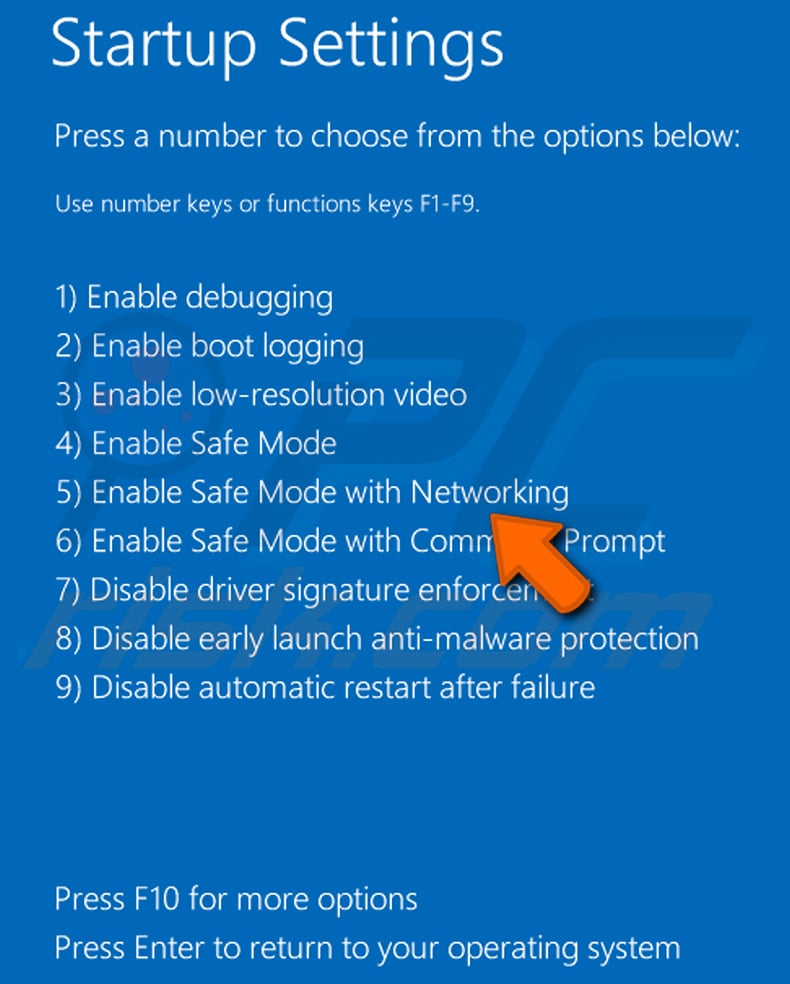
Video showing how to start Windows 10 in "Safe Mode with Networking":
 Extract the downloaded archive and run the Autoruns.exe file.
Extract the downloaded archive and run the Autoruns.exe file.
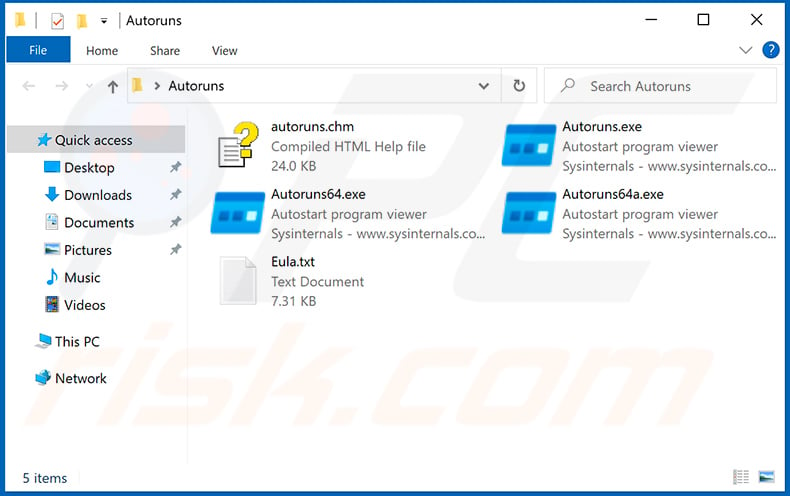
 In the Autoruns application, click "Options" at the top and uncheck "Hide Empty Locations" and "Hide Windows Entries" options. After this procedure, click the "Refresh" icon.
In the Autoruns application, click "Options" at the top and uncheck "Hide Empty Locations" and "Hide Windows Entries" options. After this procedure, click the "Refresh" icon.
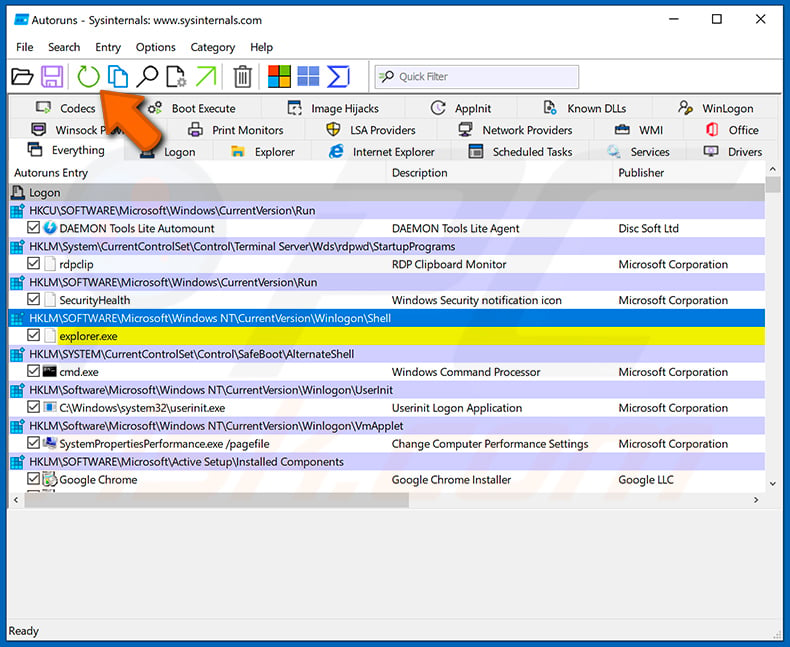
 Check the list provided by the Autoruns application and locate the malware file that you want to eliminate.
Check the list provided by the Autoruns application and locate the malware file that you want to eliminate.
You should write down its full path and name. Note that some malware hides process names under legitimate Windows process names. At this stage, it is very important to avoid removing system files. After you locate the suspicious program you wish to remove, right click your mouse over its name and choose "Delete".
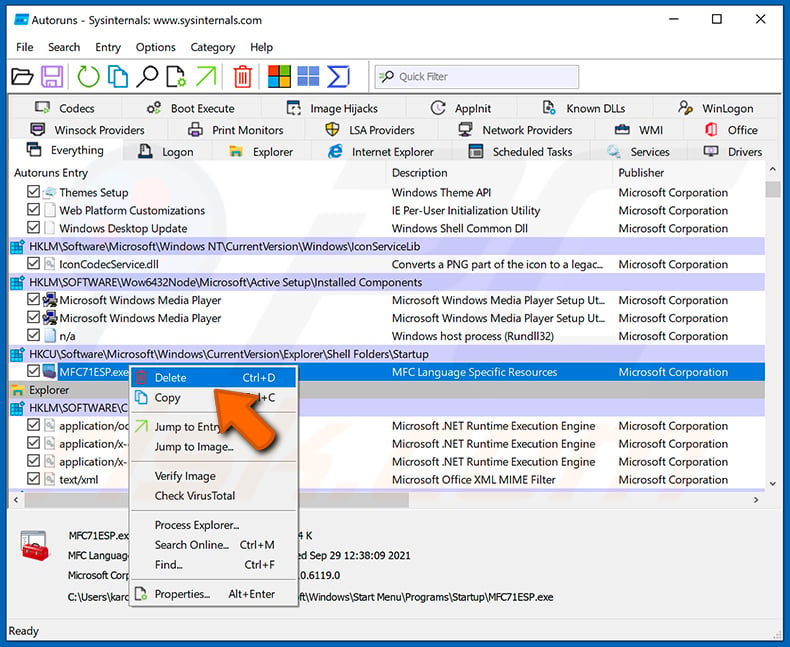
After removing the malware through the Autoruns application (this ensures that the malware will not run automatically on the next system startup), you should search for the malware name on your computer. Be sure to enable hidden files and folders before proceeding. If you find the filename of the malware, be sure to remove it.
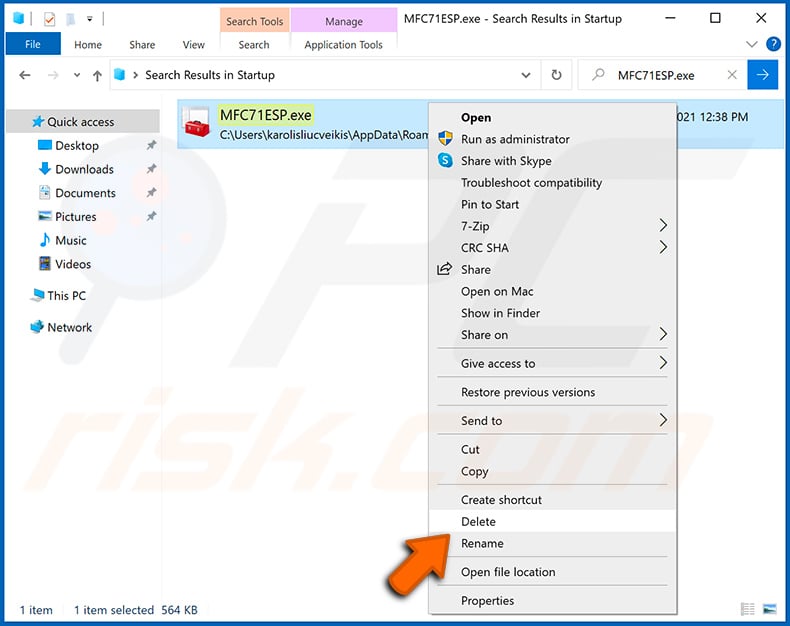
Reboot your computer in normal mode. Following these steps should remove any malware from your computer. Note that manual threat removal requires advanced computer skills. If you do not have these skills, leave malware removal to antivirus and anti-malware programs.
These steps might not work with advanced malware infections. As always it is best to prevent infection than try to remove malware later. To keep your computer safe, install the latest operating system updates and use antivirus software. To be sure your computer is free of malware infections, we recommend scanning it with Combo Cleaner Antivirus for Windows.
Frequently Asked Questions (FAQ)
My computer is infected with PS1Bot malware, should I format my storage device to get rid of it?
Malware removal rarely necessitates formatting.
What are the biggest issues that PS1Bot malware can cause?
The threats posed by an infection might depend on the malware's capabilities and the cyber criminals' modus operandi. PS1Bot is a modular malware that can use various modules for additional abilities, including persistence ensurance and data theft. Generally, high-risk infections can lead to severe privacy issues, financial losses, and identity theft.
What is the purpose of PS1Bot malware?
Malware is primarily used for profit. However, aside from generating revenue, attackers can use malicious programs to amuse themselves, carry out personal vendettas, disrupt processes (e.g., sites, services, companies, organizations, etc.), engage in hacktivism, and launch politically/geopolitically motivated attacks.
How did PS1Bot malware infiltrate my computer?
PS1Bot has been actively proliferated via malvertising campaigns. Other distribution techniques are possible.
Malware is most commonly spread through malvertising, drive-by downloads, trojans, online scams, spam emails/messages, dubious download channels (e.g., freeware and third-party websites, Peer-to-Peer sharing networks, etc.), pirated programs/media, illegal software activation tools ("cracks"), and fake updates. Some malicious programs can self-spread via local networks and removable storage devices.
Will Combo Cleaner protect me from malware?
Combo Cleaner is designed to scan computers and remove all kinds of threats. It is capable of detecting and eliminating most of the known malware infections. Remember that running a full system scan is paramount since sophisticated malicious software typically hides deep within systems.
Share:

Tomas Meskauskas
Expert security researcher, professional malware analyst
I am passionate about computer security and technology. I have an experience of over 10 years working in various companies related to computer technical issue solving and Internet security. I have been working as an author and editor for pcrisk.com since 2010. Follow me on Twitter and LinkedIn to stay informed about the latest online security threats.
PCrisk security portal is brought by a company RCS LT.
Joined forces of security researchers help educate computer users about the latest online security threats. More information about the company RCS LT.
Our malware removal guides are free. However, if you want to support us you can send us a donation.
DonatePCrisk security portal is brought by a company RCS LT.
Joined forces of security researchers help educate computer users about the latest online security threats. More information about the company RCS LT.
Our malware removal guides are free. However, if you want to support us you can send us a donation.
Donate
▼ Show Discussion